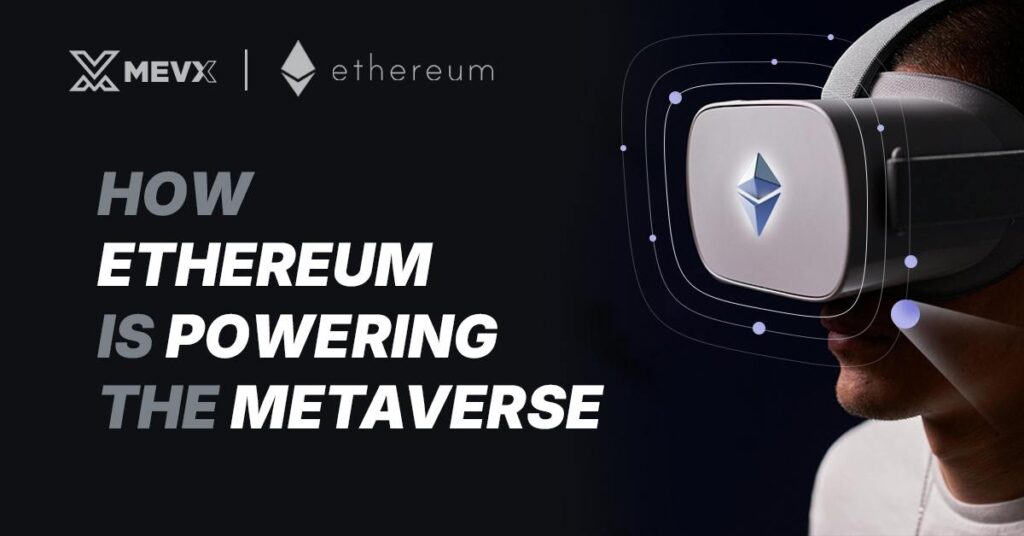The metaverse represents a much-broadened concept that rejuvenates how interactions should be done in the digital space. It connects the physical and virtual worlds through immersive experiences, jumping over real-world barriers. Right at the very center of this new innovation stands Ethereum, a blockchain platform whose strong ecosystem forms the very bedrock upon which the metaverse is based. This article discusses How Ethereum is powering the metaverse.

What is the Metaverse?
The Metaverse has also been envisioned as an interconnected, shared, simulated reality in which individuals communicate, exchange, and transact with other individuals. It aims to build an environment alongside one that naturally exists. It has initially gained relevance due to the book by Neal Stephenson, Snow Crash, released in 1992. It has expanded to signify an amalgamation of several innovations today, such as virtual reality, augmented reality, and blockchain. The metaverse shall encompass:
- Virtual worlds: Immersive digital spaces for social interaction and gaming.
- Avatars: Digital representation of the user.
- Decentralized economies: Fueled through Cryptocurrencies and Digital Assets.
- Social platforms: Communication and collaboration toolkits.
- Gaming and entertainment: Interactive and participatory experiences.
The most relevant applications of the metaverse will lie in gaming, commerce, education, and healthcare, promising revolutionary features in digital engagement.
How Ethereum is Powering the Metaverse
Ethereum is the foundation upon which most metaverses are created, hosting dApps, NFTs, and smart contracts, among other entities, to build secure transactions, ownership, and decentralized governance.
Key Ethereum Features Empowering the Metaverse:
- Smart Contracts: The programmable contract allows one to secure transactions automatically. Besides, it allows one to claim ownership over land, gaming economies, as well as decentralized governance in the metaverse.
- NFT Integration: Special types of property over lands, collectibles, as well as avatars, can be created by leveraging Ethereum through ERC-721 and ERC-1155.
- Scalability: L-2 scaling products such as Optimistic reduce transactions’ cost while enhancing speed on Ethereum while maintaining quality users’ experience.
- Interoperability: The open environment makes it possible for one to build interoperable metaverse platforms, as well as metaverse project bridges.
Ethereum Applications in the Metaverse
Developers use Ethereum to create immersive, interactive experiences across diverse applications:
1. Virtual Real Estate
Examples of these might include Decentraland, which employs Ethereum to buy, sell, and build on virtual plots of land. It secures a guarantee of ownership via NFT and the ability for transactions courtesy of the Ethereum blockchain.
2. Gaming and Play-to-Earn Models
Games like Axie Infinity show the power of Ethereum in enabling its users to earn cryptocurrency through video gaming. These models catalyze digital economies in which assets have real-world value.

3. Decentralized Marketplaces
Ethereum-powered virtual marketplaces enable people to sell everything, from digital clothes for avatars to in-game weapons. The platforms develop around the core of user ownership and value distribution.
4. Social and Creative Platforms
On metaverse projects like The Sandbox, creators can create, tokenize, and sell user-generated content. The decentralized infrastructure of Ethereum monetizes securely.
Challenges and Opportunities
Challenges:
- Scalability: This has struggled to cope with many transactions, particularly as users get greater traction.
- Interoperability: Connecting disparate metaverses has frictionless cross-chain communications.
- Regulation: Compliance with international law over data protection, IP, and digital property is challenging.
Solutions:
- Layer-2 Scaling: Rollups, sharding, etc. further enhance scaling out Ethereum for greater transactions per second while lowering fees.
- Cross-Chain Protocols: Bridges, including Polkadot, and Cosmos, offer greater interoperability.
- Regulatory Adaptation: Clear-cut protocols offer coordinating metaverses creations with universal standards.
Opportunities:
- Innovation in Virtual Economies: Ethereum imports dynamic markets and dApps to the metaverse for decentralized finance.
- Enhanced User Experiences: Having an Ethereum wallet, an NFT included, makes it possible to build very customized, secure engagements.
- Decentralized Governance: Having the option to support enabling Ethereum wallet, an NFT, on the platform makes the engagement customized but secure.
Case Studies: Ethereum in Action
- Decentraland: A platform through which users trade virtual property via Ethereum tokens and govern.
- CryptoKitties: A pioneering NFT video game that democratized collecting digitally via Ethereum.
- The Sandbox: A user-generated content platform leveraging ownership via Ethereum together with revenue streams.
- Axie Infinity: The initial play-to-earn video game that shows that Ethereum has the capacity to build an economic digital economy.
Conclusion
Ethereum is so much more than a blockchain. It is a building block of the metaverse. Because of this, it is irreplaceable in this new frontier, as it allowed for the decentralized economy and protection of digital ownership and unleashed unprecedented levels of innovation. Providing solutions for scalability and interoperability challenges, Ethereum unleashes the whole power of the metaverse, enabling a future where the boundaries between the physical and virtual worlds will blur.
Learn more about Ethereum blockchain on the MevX Blog!
Share on Social Media:
